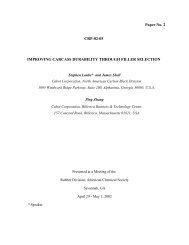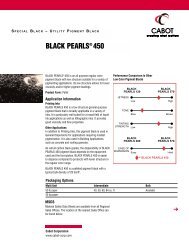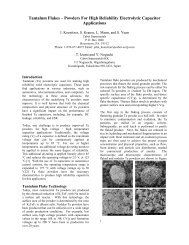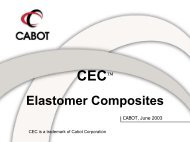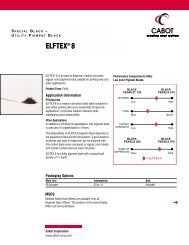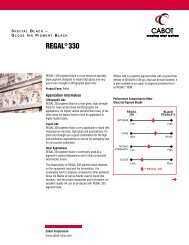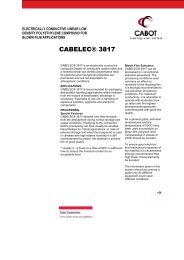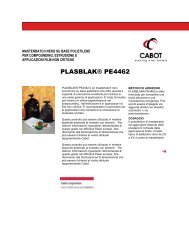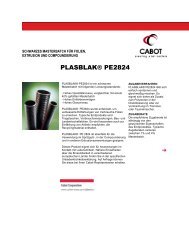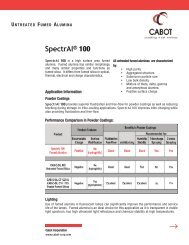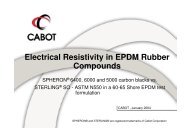UV Weathering and Related Test Methods - Cabot Corporation
UV Weathering and Related Test Methods - Cabot Corporation
UV Weathering and Related Test Methods - Cabot Corporation
You also want an ePaper? Increase the reach of your titles
YUMPU automatically turns print PDFs into web optimized ePapers that Google loves.
Artificial weathering chambers<br />
a) Q<strong>UV</strong> fluorescent light source<br />
<strong>Weathering</strong> chambers have been developed to provide a Q<strong>UV</strong><br />
weathering.<br />
The Q<strong>UV</strong> simulates the effect of sunlight with fluorescent ultraviolet<br />
(<strong>UV</strong>) lamps, while rain <strong>and</strong> dew are simulated by the condensation of<br />
humidity. As stated previously, the <strong>UV</strong> light only represents roughly 5%<br />
of the sunlight but it is responsible for most of the polymer<br />
degradation. Also, materials are often tested with equipment, which<br />
simulate only the shortest wavelengths (<strong>UV</strong>).<br />
The <strong>UV</strong>-B range includes the shortest wavelengths found in sunlight.<br />
Therefore, for many applications, it is a fast <strong>and</strong> efficient method.<br />
Q<strong>UV</strong> equipment uses two main types of lamps: <strong>UV</strong>A-340 <strong>and</strong> <strong>UV</strong>B-<br />
313.<br />
As shown in Figures 1 <strong>and</strong> 2, while these lamps have different light<br />
emission spectrum, they are both characterized by a maximum of<br />
emission in the <strong>UV</strong> range.<br />
<strong>UV</strong>A provides a reasonable match of the <strong>UV</strong> region of the solar<br />
spectrum, but this match is no longer valid for the long wavelengths<br />
(visible, IR).<br />
<strong>UV</strong>B lamps also emit <strong>UV</strong> light, but the maximum of the emission<br />
spectrum is shifted towards short wavelengths compared to the <strong>UV</strong>A<br />
lamps. The <strong>UV</strong>B-313 lamp is a widely used type of fluorescent <strong>UV</strong><br />
lamp that provides fast test results. However, as shown in Figure 2,<br />
the spectrum contains short wavelengths, which are not present in<br />
the solar radiation.<br />
Irradiance (W/2/nm)<br />
1.2<br />
1.0<br />
0.8<br />
0.6<br />
0.4<br />
0.2<br />
0.0<br />
270<br />
Figure 1: <strong>UV</strong>A-340 spectrum Figure 2: <strong>UV</strong>B-313 spectrum<br />
<strong>UV</strong>A-340 versus Sunlight<br />
<strong>UV</strong>A-340<br />
290 310 330 350 370 390<br />
Wavelength (nm)<br />
Sunlight<br />
By courtesy of QPanel<br />
Irradiance (W/m2/nm)<br />
1.2<br />
1.0<br />
0.8<br />
0.6<br />
0.4<br />
0.2<br />
0.0<br />
<strong>UV</strong>B Lamps versus Sunlight<br />
<strong>UV</strong>B-313<br />
QFS-40<br />
270 290 310 330 350 370 390<br />
Wavelength (Nm)<br />
Sunlight<br />
By courtesy of QPanel<br />
9



